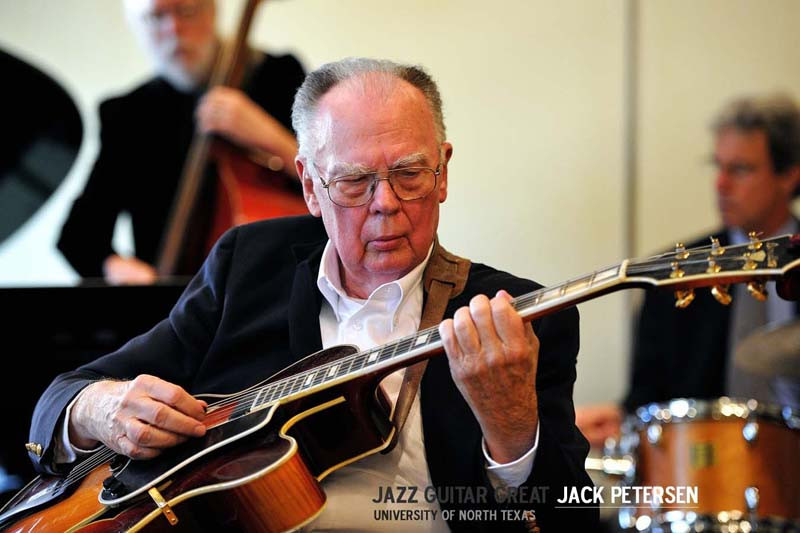Jack Petersen, a name synonymous with jazz guitar pedagogy and performance, may not be as widely recognized as some of his contemporaries, but his influence on the jazz guitar landscape is undeniable. As a pedagogical architect at institutions like Berklee College of Music and the University of North Texas College of Music, Petersen has shaped generations of jazz guitarists. His legacy, deeply rooted in the traditions of jazz guitar greats, offers a treasure trove of insights for aspiring players. One of the most valuable takeaways from Petersen’s perspective, as highlighted in a rare interview, is the importance of learning “hot licks” – those captivating phrases that define the language of jazz. This article delves into the concept of “Jack licks,” not as a specific set of phrases Petersen himself invented, but as an approach to learning and mastering jazz guitar vocabulary inspired by his journey and influences.
 Jack Petersen on guitar with the Mike Vax Sextet at The Nash Jazz Club – Joseph Berg Photography
Jack Petersen on guitar with the Mike Vax Sextet at The Nash Jazz Club – Joseph Berg Photography
The “Hot Licks” Philosophy: Imitation and Innovation
In his interview, Petersen recounts a time before formalized jazz education was widespread, emphasizing the organic way musicians learned:
“Well, they didn’t have that then, but they did have something else. It’s a thing called “hot licks.” You know, you hear a hot lick and you say to yourself, ‘hey, play that again. Let me look at it. Let me play it. Let me learn it.’ And you learn it, you know? … But I, at first, like everybody, like any child learning how to speak—starts imitating what he hears. And you do the same thing with jazz at first to get started, you know, you gotta start somewhere.”
This quote encapsulates a fundamental truth about learning jazz guitar: imitation is key. Just as a child learns to speak by mimicking sounds, jazz guitarists initially build their vocabulary by absorbing and internalizing the “hot licks” of their idols. Petersen’s journey underscores this point, advocating for a hands-on, ear-driven approach to learning. Therefore, “Jack Licks To Learn On Guitar” is not about a prescribed set of Petersen’s personal licks, but rather embodies the process he describes: actively seeking out, learning, and internalizing the characteristic phrases of jazz guitar masters.
Drawing Inspiration: Licks from Petersen’s Influences
To truly grasp the essence of “Jack licks,” we must look at the guitarists who shaped Petersen’s own playing. He explicitly mentions a pantheon of jazz guitar legends who influenced him, each with their distinct “hot licks” and stylistic trademarks. Learning licks from these players is akin to tracing Petersen’s own formative path.
Charlie Christian: The Electric Pioneer
As Petersen, an Oklahoma native like Christian, acknowledges, Charlie Christian was a monumental influence. Christian’s groundbreaking work with Benny Goodman in the late 1930s and early 1940s redefined jazz guitar. His single-note lines, horn-like phrasing, and advanced harmonic concepts became the blueprint for modern jazz guitar.
Essential Charlie Christian Licks to Learn:
- Rhythmic Displacement: Christian frequently used rhythmic displacement, shifting melodic phrases across the bar line to create syncopation and swing. Learning licks that demonstrate this technique will add rhythmic complexity to your playing.
- Chromaticism and Enclosures: Christian masterfully incorporated chromaticism and enclosure techniques to create melodic interest and navigate chord changes. Study licks featuring chromatic passing tones and enclosures around target notes.
- Blues-Infused Lines: Despite his sophisticated harmonic approach, Christian’s playing always retained a bluesy edge. Explore licks that blend blues scales and phrasing with jazz harmony.
By learning Charlie Christian licks, you’re not just acquiring phrases; you’re absorbing the foundational vocabulary of electric jazz guitar, a vocabulary that deeply resonated with Petersen.
Oscar Moore: The Foot-Patting Rhythm Master
Petersen expresses immense admiration for Oscar Moore, best known for his work with the Nat King Cole Trio. Moore’s playing is characterized by its infectious swing, melodic clarity, and impeccable time. He was a master of comping and single-note lines that were both sophisticated and deeply rooted in the groove.
Essential Oscar Moore Licks to Learn:
- Groove-Oriented Lines: Moore’s solos are always danceable and rhythmically compelling. Focus on licks that emphasize rhythmic precision and swing feel.
- Melodic Simplicity and Clarity: Moore’s lines are often deceptively simple but incredibly effective. Learn licks that prioritize melodic contour and clear phrasing over excessive complexity.
- Chordal Licks and Arpeggios: Moore was adept at incorporating chordal fragments and arpeggios into his single-note lines. Study licks that blend linear phrases with chordal ideas.
 unt-jazz-guitarist-jack-petersen-flickr-photo2a
unt-jazz-guitarist-jack-petersen-flickr-photo2a
Petersen’s appreciation for Moore’s ability to “make you pat your foot” highlights the importance of groove and rhythmic vitality in jazz guitar playing. Learning Oscar Moore licks will instill a deeper sense of swing and rhythmic sophistication in your playing.
Tal Farlow: The Virtuoso Harmonic Innovator
Tal Farlow, another guitarist Petersen deeply admired, was renowned for his incredible technical facility, advanced harmonic vocabulary, and unique melodic approach. Farlow’s playing was characterized by its fluidity, speed, and sophisticated chord voicings.
Essential Tal Farlow Licks to Learn:
- Fluid and Fast Lines: Farlow’s technical prowess allowed him to execute incredibly fast and flowing lines. Explore licks that challenge your technique and encourage fluidity and speed.
- Advanced Harmonic Concepts: Farlow was a master of using altered dominants, upper extensions, and complex chord substitutions. Study licks that incorporate these advanced harmonic concepts.
- Angular Melodies: Farlow’s melodic lines often featured unexpected twists and turns, creating angular and unpredictable phrases. Learn licks that showcase this unique melodic approach.
Petersen’s recognition of Farlow’s “incredible harmonic sense” points to the importance of harmonic depth in jazz guitar improvisation. Learning Tal Farlow licks will expand your harmonic vocabulary and melodic horizons.
Carl Kress and Barry Galbraith: The Chordal Masters
Petersen also mentions Carl Kress and Barry Galbraith, both giants of chord melody playing and sophisticated harmonic concepts. While not primarily known for single-note “licks” in the same vein as Christian or Farlow, their chordal approaches offer a different kind of “lick”—chord voicings, progressions, and harmonic movements that are essential for jazz guitarists.
Essential Kress and Galbraith Inspired “Chordal Licks” to Learn:
- Walking Bass Lines with Chords: Kress and Galbraith were masters of creating walking bass lines while simultaneously playing chords. Learn chordal licks that incorporate walking bass motion.
- Chord Melody Arrangements: Study chord melody arrangements by Kress and Galbraith to understand how they harmonized melodies and created full-sounding guitar arrangements.
- Sophisticated Chord Voicings: Explore the rich and varied chord voicings used by Kress and Galbraith, including close voicings, drop voicings, and altered chords.
 download-6
download-6
Petersen’s appreciation for Kress’s “great-sounding chords” and Galbraith’s reading and harmonic fluency highlights the importance of chordal mastery in jazz guitar. While “licks” often refer to single-note phrases, in the context of guitar, chordal vocabulary is equally crucial.
Learning “Jack Licks”: The Practical Approach
Inspired by Jack Petersen’s insights and the legacies of his influences, here’s a practical approach to learning “Jack licks” on guitar:
- Active Listening: Immerse yourself in the music of Jack Petersen’s influences: Charlie Christian, Oscar Moore, Tal Farlow, Carl Kress, Barry Galbraith, and others he mentions like Herb Ellis and Jimmy Wyble. Listen actively for phrases and ideas that catch your ear – the “hot licks.”
- Transcription and Analysis: When you hear a lick you like, try to transcribe it by ear. This develops your ear training and internalizes the lick more deeply. Analyze the lick: What scales or arpeggios are used? How does it relate to the underlying chord changes? What rhythmic devices are employed?
- Practice in All Keys: As Petersen mentions doing, practice the licks you learn in all twelve keys. This solidifies your understanding and makes the licks usable in any musical context.
- Integration and Personalization: Don’t just memorize licks in isolation. Experiment with incorporating them into your own solos and improvisations. Adapt and personalize them to fit your own style and musical ideas.
- Contextual Learning: Understand the context in which these guitarists played. Listen to entire solos and recordings to see how licks are used within a larger musical narrative.
 Jack Petersen performs in Prescott AZ 2013-Laura-Riggs-photo
Jack Petersen performs in Prescott AZ 2013-Laura-Riggs-photo
By adopting this approach, you’re not just learning isolated phrases; you’re engaging in the same process of discovery and imitation that shaped Jack Petersen’s own development. You are learning to speak the language of jazz guitar by internalizing the “hot licks” of its masters.
Beyond Licks: Embracing the Full Legacy
While “jack licks to learn on guitar” provides a focused entry point, Petersen’s interview offers broader lessons for aspiring jazz guitarists. His emphasis on sight-reading, his diverse musical experiences, and his lifelong dedication to music all contribute to a holistic picture of a successful and influential jazz musician. Exploring the full interview and Petersen’s wider contributions to jazz guitar pedagogy will further enrich your understanding and appreciation of his legacy.
Learning “Jack licks” is ultimately about embracing a learning philosophy: listen intently, imitate purposefully, analyze deeply, and personalize creatively. By following this path, inspired by Jack Petersen and the giants who shaped him, you can unlock your own jazz guitar mastery and develop a truly authentic and compelling voice on the instrument.

